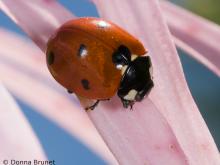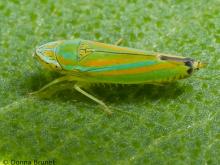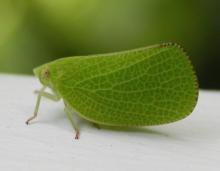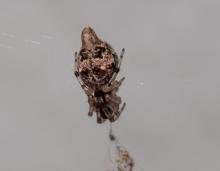Land Invertebrates
Media

Species Types
Scientific Name
Nearly 500 species in North America north of Mexico
Description
Lady beetles are beloved for many reasons. Farmers like the way they devour injurious aphids and scale insects. Everyone else appreciates their bright colors and shiny, compact bodies.
Media

Species Types
Scientific Name
About 60 species in North America north of Mexico
Description
The nymphs of spittlebugs and froghoppers are famous for hiding in small foamy masses of fluid. The “spit” conceals them as they suck juices from plant stems. The adults resemble leafhoppers.
Media

Species Types
Scientific Name
More than 400 species in North America north of Mexico
Description
The name is a warning: blister beetles are famous for their chemical defenses. Beetles in this family can exude an oil that can cause a person’s skin to blister.
Media

Species Types
Scientific Name
Tabanus, Chrysops, and related genera
Description
Meet the horse fly: Stealthily, one will land on your back, slice your skin, and lap your blood. By the time it starts to hurt and you swat at it, the painful, itchy welt is rising.
Media

Species Types
Scientific Name
Nearly 500 species in North America north of Mexico
Description
Soldier beetles are most often seen on flowers. Many species in this family are pollinators. Yellow, orange, and red are their most common colors, besides black and brown.
Media

Species Types
Scientific Name
More than 600 species in North America north of Mexico
Description
The mayflies are a fascinating group of insects. The nymphs live from months to years under water, and the delicate adults fly around in the air, mating, living for only a day or two.
Media

Species Types
Scientific Name
More than 3,000 species in North America north of Mexico
Description
The leafhoppers are a large and diverse family of sap-sucking, hopping insects. You can distinguish them from similar groups of hoppers by the hind legs, which have at least one row of small spines on the hind tibiae (“shins”).
Media

Species Types
Scientific Name
More than 900 species in North America north of Mexico
Description
Planthoppers are a large and diverse group of small hopping bugs. They tend to be less abundant than other types of hoppers.
Media

Species Types
Scientific Name
More than 260 species in North America North of Mexico
Description
Treehoppers can resemble thorns, bark, weird plant bumps, or tiny leaves. If you can recognize one of these as an insect, you're doing well!
Media

Species Types
Scientific Name
Cyclosa conica and C. turbinata
Description
Trashline orbweavers decorate their small, circular webs with an unimpressive line of insect husks and other debris. The small orbweaver rests at the hub within this line of garbage, looking like just another bit of trash.
See Also



Media

Species Types
Scientific Name
Cisseps fulvicollis
Description
The yellow-collared scape moth is more often “orange-collared.” And whether you think it looks more like a firefly or a wasp, it’s still a moth!
Media

Species Types
Scientific Name
Nearly 150 species in North America north of Mexico
Description
Slim, delicate plume moths are instantly recognizable by their T-shaped silhouette, long legs, and muted shades of tan and brown. It can be hard to separate the various species.
Media

Species Types
Scientific Name
Pyrrharctia isabella
Description
Not many people know the adult Isabella tiger moth when they see one, but we’re all acquainted with its caterpillar, the woolly worm, or woolly bear.
About Land Invertebrates in Missouri
Invertebrates are animals without backbones, including earthworms, slugs, snails, and arthropods. Arthropods—invertebrates with “jointed legs” — are a group of invertebrates that includes crayfish, shrimp, millipedes, centipedes, mites, spiders, and insects. There may be as many as 10 million species of insects alive on earth today, and they probably constitute more than 90 percent all animal species.





















